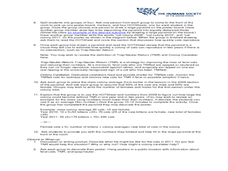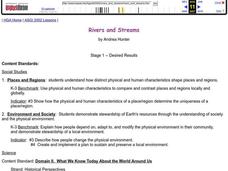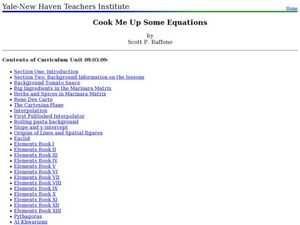Curated OER
My Feelings
First graders examine and discuss different emotions and feelings, and how people can react when they are in an unsafe situation. They discuss a feelings thermometer, and complete a worksheet involving identifying how they feel in...
Curated OER
Make a Dinosaur
Students estimate the size of dinosaurs and create a dinosaur model. They create bar graphs of the sizes of dinosaurs one in meters and the other in "student" units. They draw a pictures and add words or sentences about their dinosaur.
Curated OER
"Is a Blue Whale the Biggest Thing There Is?" by Robert Wells
Students discuss how big is big. They compare the area and perimeter of an acre and a football field.
Curated OER
I Think I Forgot Something!
Students examine human health by reading a children's book in class. In this breakfast lesson, students identify the importance of starting the day with a good, nutritious meal. Students read the book I Think I Forgot Something and...
Curated OER
The Tale of the Feral - Care and Multiplication of Feral Cats
Pupils differentiate between a feral cat and a domesticated cat. In this cat lesson plan, students use the scientific method, calculate averages, solve story problems, and learn how a caretaker can help a feral colony live safely.
Curated OER
Little Red Hen
First graders explore biology by identifying plant anatomy in class. In this botany lesson, 1st graders read the book The Little Red Hen and identify the methods used in order to grow successful plants. Students discuss other ways people...
Curated OER
Making Good Decisions
Students read an article. For this problem solving lesson, students read an article where they must solve the problem presented. Students work in groups to discuss the issue and come up with a way to solve the problem.
Curated OER
Governments of the World
Students examine how different world governments function and interact with each other. In groups, they research one of the five types of governments. Students prepare news magazines, Powerpoint presentations, and newspaper storyboards...
Curated OER
Periodic Pigment
Students make paint using the ingredients from recipes from the 17th century. In this paint making lesson plan, students follow a recipe with vegetable oil, eggs, pigment, paintbrushes, and more to make their paint.
Curated OER
On the Mayflower Lesson Plan
Students create a model of the Mayflower. In this early childhood lesson plan, students engage in dramatic play while reenacting the Pilgrims and the Mayflower. Students listen as the instructor reads On the Mayflower by Kate Waters.
Curated OER
Using Primary Sources: Letters from the Presidents
Learners find out about the minds and thoughts of presidents through reading their actual letters. They explore the personal lives of presidents. They answer questions about a primary source. They write essays.
Curated OER
Rivers and Streams
Students research the rivers, streams and water bodies of Hawaii. They read a variety of books, play Bingo with water-related terms, create and maintain water-themed journals, view videos, conduct Internet research and participate in a...
Curated OER
I'm A Star!
Fourth graders answer questions about being responsible community member. They listen and brainstorm ideas of why it important to be responsible community members. Students are given a copy of "I'm A Star Community Member" game...
Curated OER
M&M Probability
Students apply the scientific method in order to determine the probability of specific colors in a bag of M&M's. They determine the definition of probability and how it can be used. They make a hypothesis and conduct an experiment to...
Curated OER
What are Comfortable (good) and Uncomfortable (bad) Feelings and Situations?
First graders explore and discuss how someone feels when they are not in a safe place or situation and how someone might react when put in an unsafe situation. They view a demonstration performed by puppets that express good and bad...
Curated OER
Our Classroom Party
Students are shown the importance of planning events in the context for having a class party. The counselor comes to the class to take a survey of how many students are interested to have a party. The teacher can use this activity to...
Curated OER
Diversity Day
Eleventh graders explore a variety of different cultures and their traditions. They complete an evaluation and short reflection of the day on the following prompts: I learned I... and I wish I... Each student then observes and talks with...
Curated OER
Plant a Seed of Kindness
Students perform acts of kindness. For this character lesson, students cut out seed shapes and write down their acts of kindness on them. Students place the seeds on a bulletin board where they "plant" them below the grass...
Curated OER
Dichotomous Keys
Students define the word dichotomous and explain why a dichotomous key is a useful tool in identifying different species. Then they look up words they are unfamiliar with or mollusk reference books so students can
learn the names of...
Curated OER
Utah's Harvest
Fourth graders recognize the importance of the physical geography on a community. In this commodities lesson, 4th graders graph the five most important commodities of Utah. Students understand why these commodities are so...
Curated OER
Cook Me Up Some Equations
Students study a variety of math concepts in the context of cooking up a meal. In this math activity, students calculate surface area and volume. They draw and interpret different types of graphs.
Curated OER
Illustrating Endangered Species
Students conduct research to answer the questions for each section. They critique a work of art using the levels of art criticism. Also they prepare gathered facts for a final presentation.
Curated OER
Children, Children, What Did You See?
Students listen to a read aloud of Brown Bear, Brown Bear, What Do You See? They write a story based on naming and drawing things they saw when they visited the Black Bayou Lake refuge.
Curated OER
Blood Business
Students identify the different kinds of blood. In this biology lesson, students investigate the antigens, agglutinins and Rh factor using their own blood. They use Punnett squares to predict blood type of offspring.
Other popular searches
- K 2 Life Science Growth
- K 2 Life Science Living
- K 2 Life Science Insects
- K 2 Life Science Salamander
- K 2 Life Science Hibernation
- K 2 Life Science Adaptation
- K 2 Life Science Cells
- K 2 Life Science Nonliving
- K 2 Life Science Wind

























